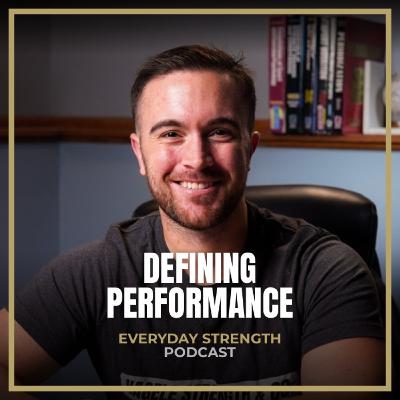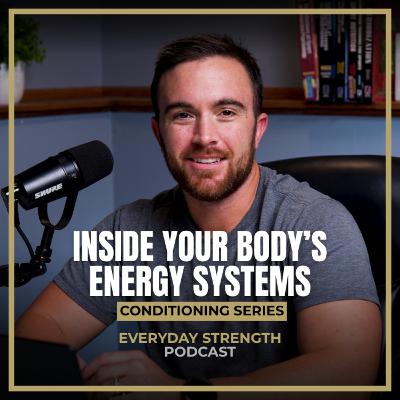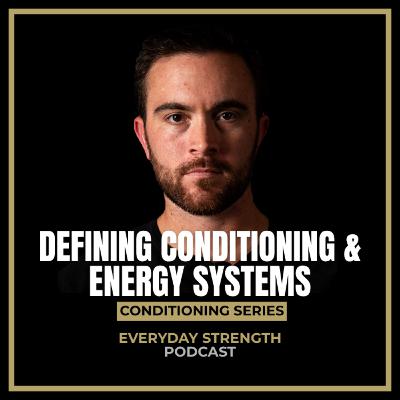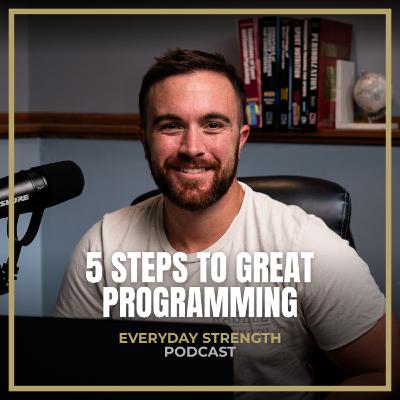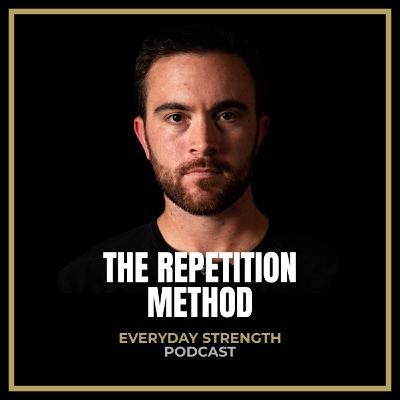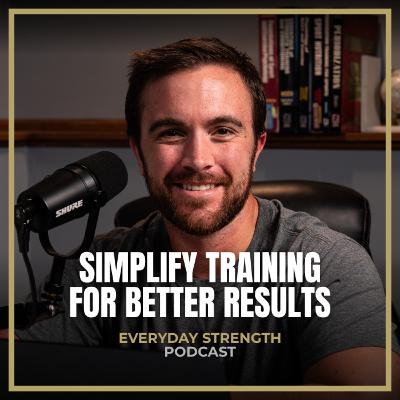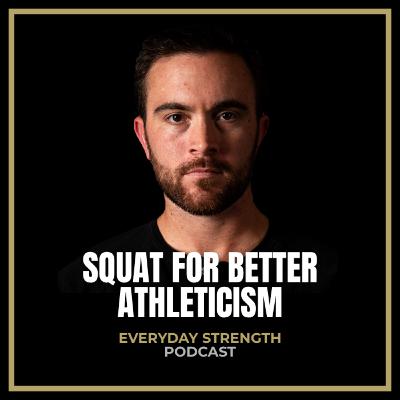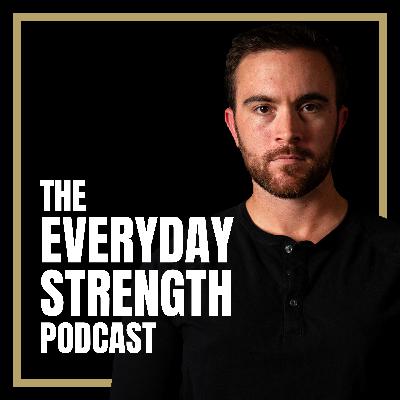Discover Everyday Strength Podcast
Everyday Strength Podcast

Everyday Strength Podcast
Author: Anthony Hagele
Subscribed: 0Played: 0Subscribe
Share
© Anthony Hagele
Description
The Everyday Strength Podcast explores the science and strategy behind becoming strong, athletic, and capable for life.
Hosted by Anthony Hagele, a coach, researcher, and hybrid athlete, the show blends evidence-based training, conditioning, and nutrition with real-world experience. Each episode gives you practical insight into how to train, fuel, and perform at a higher level while managing the demands of work, family, and life.
Drawing from sports science, strength training, and human performance research, Anthony breaks down what actually works for everyday athletes who want to stay lean,
Hosted by Anthony Hagele, a coach, researcher, and hybrid athlete, the show blends evidence-based training, conditioning, and nutrition with real-world experience. Each episode gives you practical insight into how to train, fuel, and perform at a higher level while managing the demands of work, family, and life.
Drawing from sports science, strength training, and human performance research, Anthony breaks down what actually works for everyday athletes who want to stay lean,
22 Episodes
Reverse
Performance is one of the most overused words in fitness, but most people never stop to define it. In this episode, Anthony breaks down what performance really means by separating capacity from skill and explaining why the basics still drive long-term improvement. You’ll learn how to evaluate your own performance, what truly moves the needle, and how to build the physical and mental qualities that hold up under pressure.Read the full episode notes at hagelestrengthJoin the Performance Edge Network to receive Anthony’s weekly newsletterTimestamps:(0:00) Episode intro(0:04) What “performance” actually means(1:22) Why performance varies across individuals(3:15) Capacity, skill, and the F1 analogy(5:29) Early adaptations and long-term development(8:42) Basics vs flashy training(12:37) Defining performance for your goals(15:19) Closing thoughts and takeawaysDisclaimers & DisclosuresConnect with Anthony:InstagramXYouTube
Plyometrics are one of the most misunderstood elements of training, yet they influence strength, speed, running efficiency, and long-term athleticism more than most people realize. In this episode, Anthony breaks down what plyometrics actually are, how they differ from basic jumps, why they matter for everyday athletes, and how they support both performance and longevity. You will also learn how to integrate plyometrics safely, how to build progressions, and how they fit into hybrid and conjugate-style programming.Read the full episode notes at Hagele StrengthJoin the Performance Edge Network to receive Anthony’s weekly newsletter.Timestamps:(0:00) Introduction(0:30) What plyometrics actually are(1:10) The stretch-shortening cycle explained(2:00) Why most “jumps” are not true plyometrics(3:00) Tendon stiffness, elastic energy, and neural drive(4:15) Power loss with age and why plyos matter for longevity(5:30) Why everyday athletes should include plyometrics(6:30) Athleticism, movement quality, and injury risk reduction(7:20) Plyometrics for hybrid athletes and runners(8:10) Running mechanics, tendon elasticity, and efficiency(9:20) Injury risk in running and why plyos build durability(10:20) Improving running economy and ground contact times(11:15) Practical plyometric options for runners(12:00) How to integrate plyos before lifting and after runs(12:30) The importance of proper progressions(13:00) Learning to land: the starting point(13:45) Low-level elastic work: pogos, skips, jump rope(14:50) Submaximal jumps and intent-based training(15:30) True plyometrics: depth jumps, hurdle hops, bounding(16:15) Managing volume, ground contacts, and frequency(17:10) Surfaces, injury prevention, and environmental considerations(17:40) Common mistakes to avoid with plyometric training(18:30) Technique, quality, and avoiding “conditioning disguised as plyos”(19:20) Fatigue, timing, and why placement in the session matters(20:10) Practical examples for strength and hybrid athletes(21:30) Weekly integration strategies and simple templates(22:00) Final takeaways(22:40) Closing remarksDisclaimers & Disclosures
We’ve all heard that sleep is important—but how bad is one bad night really? In this week’s episode, Anthony unpacks the physiology behind acute sleep deprivation and explains why even a few hours less can have measurable effects on strength, endurance, hormones, and mental performance.In This Episode You’ll Learn:What happens to your body and brain after a single poor night of sleepHow sleep loss impacts testosterone, growth hormone, cortisol, and glycogen resynthesisWhy your reaction time, coordination, and balance mimic being legally drunkThe drop in strength and endurance you can expect (with real data ranges)How to modify your training to reduce injury risk when you’re tiredEvidence-backed strategies to bounce back — caffeine, creatine, naps, and recovery routinesHow to prevent one night of poor sleep from turning into a full-blown performance declineKey Takeaways:Even one night of <5 hours sleep can reduce testosterone 5–10% and halve growth hormone release.Reaction times and decision-making degrade to the level of legal intoxication after ~24 hours awake.Training at high intensity while sleep-deprived increases injury risk — focus on technique and aerobic work instead.Creatine (20–30 g acutely) may offset cognitive decline from sleep deprivation.Sleep hygiene and recovery practices can restore performance faster than you think.Timestamps:00:00 – Intro: How bad is one night of sleep?01:15 – What happens physiologically when you’re sleep deprived03:00 – Hormones and recovery breakdown04:45 – Reaction time and cognitive performance06:00 – How sleep loss affects strength and endurance08:30 – How to train when you’re sleep deprived11:00 – Creatine and cognitive protection14:00 – Caffeine, naps, and recovery tools16:30 – Sleep hygiene and recovery habits19:00 – Final takeaways and key lessonsReferenced Resources:Why We Sleep by Matthew WalkerGordji-Nejad, A., Matusch, A., Kleedörfer, S. et al. Single dose creatine improves cognitive performance and induces changes in cerebral high energy phosphates during sleep deprivation. Sci Rep 14, 4937 (2024). https://doi.org/10.1038/s41598-024-54249-9
In this episode, Anthony Hagele breaks down one of the three cornerstone methods of the Conjugate system: the Max Effort Method for the lower body. You’ll learn what it is, what it’s not, and how to program it the right way.Anthony dives into the physiology behind true maximal strength development, from motor unit recruitment and rate coding to force production and movement coordination, then walks you through exactly how he programs max-effort work for everyday athletes, hybrid competitors, and pros alike.Whether you’re chasing a bigger squat, a faster 5K, or just want to bulletproof your body, this episode gives you the framework to get stronger for life.In this episode we cover:What the Max Effort Method really is — and why it’s misunderstoodHow to implement it safely for long-term resultsThe science behind strength and “strain”Why rotation and variation are your best recovery toolsThe biggest mistakes lifters make with max-effort trainingHow to plug this method into your own programTimestamps00:00 – Intro: What the Max Effort Method is and why it matters02:00 – Why every athlete needs maximal strength05:00 – The intent behind “strain” and what makes it different from volume training07:00 – The science: motor unit recruitment, rate coding, and coordination10:00 – Practical benefits: performance, longevity, injury prevention11:00 – Programming structure: when and how often to use Max Effort14:00 – Inside a full Max Effort session (warm-up to accessories)21:00 – How to choose variations (squat, deadlift, good morning, etc.)27:00 – How long to stick with each variation and when to rotate29:00 – Understanding “technical max” vs. “absolute max”32:00 – Common mistakes: ego lifting, lack of rotation, poor recovery36:00 – Final takeaways and how to implement this method safely
In this episode, Anthony breaks down how to actually train your energy systems, including the aerobic, glycolytic, and phosphagen system, using real physiological principles, not guesswork. You’ll learn how to program conditioning that builds performance, not just burns calories.We cover:How to structure your conditioning across accumulation, intensification, and realization phasesThe exact methods for each system (cardiac output, tempo intervals, glycolytic intervals, alactic power work, and more)How to manage CNS load and stress so you’re not crushing recoveryHow to integrate all three systems into a conjugate-style structure that drives year-round progressIf you’ve ever felt lost on how to program conditioning, this is your blueprint.Show Notes: 00:00: Intro & recap of the conditioning series01:00: The aerobic system: cardiac output, tempo, and strongman endurance09:20: The glycolytic system: power, capacity, and hybrid circuits14:00: The phosphagen system: power, capacity, and contrast training17:55: Vertical integration & residual training effects20:00: Stress management and CNS load21:45: Practical guidelines & wrap-upMentions & ResourcesPrevious Episodes:Episode 15: Conditioning Part 1Episode 16: Conditioning Part 2Learn more about training with me: hagelestrength.com/programsJoin the Performance Edge Network for exclusive articles: hagelestrength.com/subscribe
In this week’s episode of the Everyday Strength Podcast, Anthony Hagele breaks down the physiology behind conditioning and how your body actually creates, regenerates, and utilizes energy during training.We go beyond the surface-level “cardio” talk and dig into the three internal engines that power every performance:The Aerobic (Oxidative) System: your foundation for endurance, recovery, and overall cardiovascular health.The Glycolytic (Anaerobic) System: that middle gear that drives high-intensity work and lactate tolerance.The Phosphagen (Alactic) System: your top-end power source, responsible for short bursts, heavy lifts, and maximal efforts.You’ll learn how each system actually produces ATP, what adaptations occur inside the muscle and heart, and why understanding these systems is the key to smarter conditioning and better performance.This is part two of the Conditioning Series. In part one, we redefined what conditioning really means. In part three, we’ll cover how to train each of these systems intelligently using proven programming methods.Timestamps00:00: Intro — Conditioning Series overview00:40: What conditioning really means01:37: The three energy systems explained01:58: Aerobic (Oxidative) System — the foundation03:57: Step-by-step: how the aerobic system creates ATP05:02: Adaptations: heart, mitochondria, and capillaries06:54: Enzyme and substrate efficiency improvements08:09: Why aerobic conditioning builds your performance base09:02: Glycolytic (Anaerobic) System — the middle gear10:25: Glycolysis explained and what causes “the burn”11:14: The truth about lactate and energy production12:27: Adaptations: enzymes, buffering, and cardiac response13:58: Phosphagen (Alactic) System — short-term power15:34: Creatine, ATP regeneration, and recovery16:46: Neural efficiency and rate coding adaptations17:11: How all three systems interact — the “relay race” analogy18:59: Vertical integration and training residuals20:00: Why understanding this matters for your training21:01: What’s coming in Part 3 — training the systems22:09: Final thoughts — function over fatigue22:47: Outro — subscribe and stay tuned for next weekLinks🔗 Train with Hagele Strength: hagelestrength.com/programs📬 Join the Performance Edge Newsletter: hagelestrength.com/all-articles🎧 Listen on Spotify / Apple Podcasts: hagelestrength.com/podcastDisclaimers & Disclosures
In this first episode of the Everyday Strength Conditioning Series, Anthony breaks down what conditioning actually means, how it’s different from cardio, and why understanding your energy systems matters.We'll cover:Why “conditioning” isn’t the same as steady-state cardioWhat ATP is, and why it’s the real energy currency of your bodyThe three energy “gears": phosphagen, glycolytic, and oxidativeHow these systems overlap and fuel everything from sprints to marathonsWhy chasing adaptation beats chasing exhaustionThis episode sets the foundation for the rest of the series: Part 2 (deep dive into the energy systems) and Part 3 (methods and programming).Show Notes:0:00 – Intro: Conditioning vs. cardio1:00 – Cardio’s role for calorie burn and health3:30 – Why conditioning matters for performance5:00 – Common misunderstandings about “just cardio”6:00 – What ATP is and why it’s like money in your checking account8:20 – The three gears of energy production9:25 – Phosphagen, glycolytic, and oxidative systems explained11:30 – How the systems overlap in real life12:30 – Conditioning vs. Energy System Development (ESD)13:00 – Residuals, conjugate method, and why aerobic work is always in the mix14:30 – The real goal: chase adaptation, not exhaustion15:30 – Preview of upcoming episodes in the series16:40 – Takeaway: Conditioning isn’t cardio, it’s energy production🔗 Links & ResourcesFollow Hagele Strength: Instagram | WebsiteSubscribe to the Everyday Strength Podcast on YouTubeBlog & programs: hagelestrength.com/all-articlesDisclaimer & Disclosures
Most supplements promise the world, but very few actually deliver. In this episode of the Everyday Strength Podcast, Anthony breaks down the handful of performance supplements that have real scientific backing and can truly move the needle for everyday athletes.We’ll cover:Why supplements are only the “icing on the cake” after training, nutrition, and recoveryThe 5 core supplements with strong evidence: creatine, caffeine, protein, beta-alanine, and nitratesHonorable mentions like sodium bicarbonate, electrolytes, omega-3s, and probioticsHow to avoid wasting money on shady products and spot the red flags in supplement marketingTakeaway: supplements won’t make or break you, but used correctly, they can provide that extra 2–5% edge that separates good from great.🔗 Subscribe to join the Performance Edge Network for deeper dives into training, nutrition, and performance: hageleStrength.com/subscribe
In this episode of the Everyday Strength Podcast, Anthony breaks down his 5-step framework for writing a training program. The discussion covers:How to decide on a training split that matches your schedule and recovery abilityChoosing between linear, block, and conjugate systems depending on your contextApplying proven methods like max effort, dynamic effort, repetition effort, and conditioning progressionsSetting the details (sets, reps, rest periods, loading schemes) without overcomplicating the processUsing feedback and iteration to adjust programming and ensure consistent progressThis episode provides a clear system you can use to plan training with more intention, recover better, and evaluate whether your approach is moving you toward your goals.📩 Subscribe to the Performance Edge Newsletter for weekly training and nutrition insights: hagelestrength.com/newsletter🎧 Listen on Spotify, Apple Podcasts, and YouTube.🏋️♂️ Programs & coaching: hagelestrength.com/shop🔗 Follow on Instagram: instagram.com/hagelestrength
Can you really build strength and conditioning at the same time? Or does cardio kill your gains? In this episode, Anthony Hagele breaks down the interference effect in concurrent training and how to program for both strength and endurance without sabotaging progress.In this episode we'll cover:Why the “cardio kills gains” myth is outdatedWhat the research says about strength, power, and endurance when combinedThe five levers you can control (order, spacing, modality, volume, intensity)Practical ways to structure your week for strength and conditioningIf you’ve ever wondered how to balance lifting and cardio, this is the playbook.🔗 Links & Resources:Follow me on Instagram: instagram.com/hagelestrengthCheck out my training programs: hagelestrength.com/shopSubscribe to my free weekly newsletter: hagelestrength.com/newsletter🎧 If you enjoyed the episode, leave a review and share it with a friend!
The repetition method often gets overshadowed by max effort and dynamic effort work — but it’s one of the most powerful tools for building muscle, protecting your joints, and improving long-term performance.In this episode of Everyday Strength, Anthony Hagele explains what the repetition method is, how it works, and exactly how to program it into your training. Whether you’re a hybrid athlete, strength enthusiast, or just want to train smarter, this method can unlock better size, strength, and resilience.🔗 Links & Resources:Follow me on Instagram: instagram.com/hagelestrengthCheck out my training programs: hagelestrength.com/shopSubscribe to my free weekly newsletter: hagelestrength.com/newsletter🎧 If you enjoyed the episode, leave a review and share it with a friend!
In this episode of Everyday Strength, I break down how minimalist training can help you get stronger, look more athletic, and build conditioning without spending hours in the gym. You'll learn why simplicity beats complexity, how to master the basics, and how to structure your week for both strength and endurance.Topics Covered:Why over complication ruins progress and enjoyment in training.The 5 foundational movement patterns every program must include.How the 80/20 rule applies to strength and conditioning.Weekly training splits for 3-4 sessions per week that actually work.Pitfalls to avoid: overstuffing, chasing novelty, skipping conditioning.Why minimalist training is simple, but far from easy.Minimalist training isn't about shortcuts. It's about stripping away the excess and putting full intent into what matters most. At Hagele Strength, every program is built on this philosophy, helping busy athletes and professionals get stronger, leaner, and better conditioned without wasting time or energy on what doesn't move the needle.🔗 Links & ResourcesFollow me on Instagram: instagram.com/hagelestrengthCheck out my training programs: hagelestrength.com/shopSubscribe to my free weekly newsletter: hagelestrength.com/newsletter🎧 If you enjoyed. this episode, leave a review and share it with a friend!
In this weeks episode, Anthony breaks down why squatting is one of the most important lifts for building athleticism. From bodyweight goblet squats to a two-times bodyweight back squat, and finally to moving heavy loads fast, you’ll learn why the squat is the foundation of strength, speed, and power.Anthony also explains why he programs with the Conjugate Method. A system that balances heavymax-effort work with dynamic speed training, and why it works better for everyday athletes than rigid linear periodization.This week we cover:Why simply "just squatting" is one of the first steps most people skipThe strength baseline: why a 2x body weight squat is a solid athletic standardHow to unlock athletic power with dynamic effort squats (squat heavy fast)Why conjugate fits better than linear training for busy athletesPractical ways to program squats into your training weekResources & Links
I’m Anthony Hagele, strength coach at Hagele Strength and an exercise and performance nutrition researcher at Lindenwood University. I created the Everyday Strength Podcast to bridge the gap between high-level performance science and the reality of being a busy everyday athlete.This show is built for men who want to be strong, lean, athletic, and healthy without having to sacrifice family, work, and life outside the gym. Each week, I break down the science of training and nutrition into practical, no-nonsense strategies that you can actually use. You’ll hear deep dives into programming, why certain methods work, how to structure your week, and what it really takes to become incredibly strong and well conditioned.We’ll cover themes like the Conjugate Method adapted for hybrid athletes, energy system development for conditioning, and the nutrition strategies that fuel both performance and longevity. We’ll dig into how to train for health and performance, not one at the expense of the other.Along the way, you’ll also hear about mindset, discipline, and the lessons that carry beyond the gym. Because being an everyday athlete is about more than chasing numbers, it’s about building a body and lifestyle that can keep up with your kids, withstand stress, and thrive for decades.You can expect episodes that blend evidence-based research with practical application, drawing from my work in exercise science, my coaching experience, and my own training journey. The goal is always the same: to equip you with tools, insights, and systems that make you better. Stronger. Healthier. And ready for whatever life throws at you.If you’re tired of cookie-cutter fitness advice and want a podcast that goes deep while staying grounded in the realities of everyday life, you’re in the right place. Stay tuned for new episodes dropping every week.
Most people train their core wrong. They think crunches and sit-ups are enough — but they’re skipping the very foundation of what the trunk is meant to do. In this episode, I’m breaking down the science, the programming, and my 5 most-used trunk exercises for strength, performance, and injury prevention.We cover:• Why I prefer the term trunk musculature and the exact anatomy it includes• The three tiers of trunk training: intrinsic, dynamic, and ballistic stability• How to program each tier into your week• The physiology behind trunk stability and force transfer• My top 5 trunk exercises, why they work, and how to make them harder• How to think about “core” training if you’re an athlete, coach, or serious lifterThis isn’t about random ab workouts. It’s about building a stable, powerful trunk that carries over to every lift, sprint, throw, and carry you do. At Hagele Strength, everything starts with a clear framework backed by research and proven in the weight room. The trunk is no exception, and once you understand how to train it, you’ll never go back to guessing.🔗 Links & Resources:Follow me on Instagram: instagram.com/hagelestrengthCheck out my training programs: hagelestrength.com/shopSubscribe to my free weekly newsletter: hagelestrength.com/newsletter🎧 If you enjoyed the episode, leave a review and share it with a friend!
If you’ve been asking yourself “How many sets and reps should I do to get stronger?” — this episode will give you a clear, evidence-backed answer.We’ll break down exactly how to structure your training for strength, including the set-rep schemes I use most often, the research that supports them, and advanced methods to layer in once you’ve built a solid foundation. Whether you’re an athlete, a coach, or a dedicated lifter, you’ll leave this episode with the knowledge to program smarter and train with more purpose.Here’s what we cover:How strength is built: volume, intensity, frequency, and progressionPrilepin’s Chart explained for practical programmingWhy certain rep ranges work better for certain phasesHow to choose between set and rep schemes based on your goalsThe baseline sets, reps, and rest periods for strength gainsAdvanced methods: cluster sets, wave loading, rest-pause training, and overwarm singlesHow to plug these methods into a 4-week block without overtrainingCommon mistakes when applying advanced techniquesStrength is a skill as much as it is a physical quality. At Hagele Strength, I design training that respects both. This episode will show you how to apply proven frameworks with the precision of a coach—so you can progress in the gym with intention.🔗 Links & Resources:Follow me on Instagram: instagram.com/hagelestrengthCheck out my training programs: hagelestrength.com/shopSubscribe to my free weekly newsletter: hagelestrength.com/newsletter🎧 If you enjoyed the episode, leave a review and share it with a friend!
Most people assume missing a few workouts means they’re losing progress, but that’s not how the body works.In this episode, Anthony breaks down the science of training residuals: how long different physical qualities actually last once you stop training them, and how to use that knowledge to program smarter.🎯 In this episode:What training residuals are and why they matterHow long strength, endurance, speed, and power stick aroundWhy some qualities fade fast — and others hold for weeksHow Anthony is applying this during his HYROX prepSmart programming strategies for everyday athletes with limited timeWhether you’re programming for yourself or others, understanding training residuals lets you train with more intention, less stress, and better results over the long term.🧠 Learn how to use these concepts to build programs that work, without doing everything, all the time.🔗 Links & Resources:Follow me on Instagram: instagram.com/hagelestrengthCheck out my training programs: hagelestrength.com/shopSubscribe to my free weekly newsletter: hagelestrength.com/newsletter🎧 If you enjoyed the episode, leave a review and share it with a friend!
Is Zone 2 the magic bullet for fat loss, mitochondrial health, and longevity? Or is it just another overhyped trend?In this episode, we break it down and dissect the latest research on Zone 2 training, including a new narrative review published in Sports Medicine. You’ll learn:What Zone 2 training really is (and isn’t)Why it may fall short for mitochondrial healthWhether it’s truly best for fat oxidationThe role of VO2max in health and longevityHow everyday athletes can program Zone 2 effectivelyWhy pro athlete protocols don’t always apply to youIf you care about performance, metabolic health, or just training smarter then this episode is for you.🔗 Links & Resources:Follow me on Instagram: instagram.com/hagelestrengthCheck out my training programs: hagelestrength.com/shopSubscribe to my free weekly newsletter: hagelestrength.com/newsletter🎧 If you enjoyed the episode, leave a review and share it with a friend!
Strongman-style conditioning might be one of the most underrated tools for building functional strength and work capacity, especially for everyday athletes. In this episode, we'll break down exactly how to program it, why it matters, and how to dial it in for long-term progress.Topics Covered:What Strongman Conditioning really is (and isn’t)Why it works for busy everyday athletesKey tools: sleds, carries, sandbags, medballsHow to program it weeklyMistakes to avoid and how to dial it in for results🔗 Links & Resources:Follow me on Instagram: instagram.com/hagelestrengthCheck out my training programs: hagelestrength.com/shopSubscribe to my free weekly newsletter: hagelestrength.com/newsletter🎧 If you enjoyed the episode, leave a review and share it with a friend!
In this episode, I break down exactly how to structure your training year using a system I call Training with the Seasons. This is a practical framework for everyday athletes looking to keep making progress year-round.You’ll learn how to rotate your training focus across the year for better results, more consistency, and long-term athleticism. We cover periodization basics, how to align training with real life, how to approach conditioning, and the biggest mistakes to avoid when planning your year. Whether you train 3 days or 6 days a week, this episode gives you the clarity and structure you need to train with intention and stay in the game.Topics covered:What is periodization (and why it matters)Seasonal phases: Winter, Spring, Summer, FallConditioning all year: aerobic, anaerobic, strongman-styleHow to train through holidays, vacations, and chaosMistakes that stall progress🔗 Links & Resources:Follow me on Instagram: instagram.com/hagelestrengthCheck out my training programs: hagelestrength.com/shopSubscribe to my free weekly newsletter: hagelestrength.com/newsletter🎧 If you enjoyed the episode, leave a review and share it with a friend!


